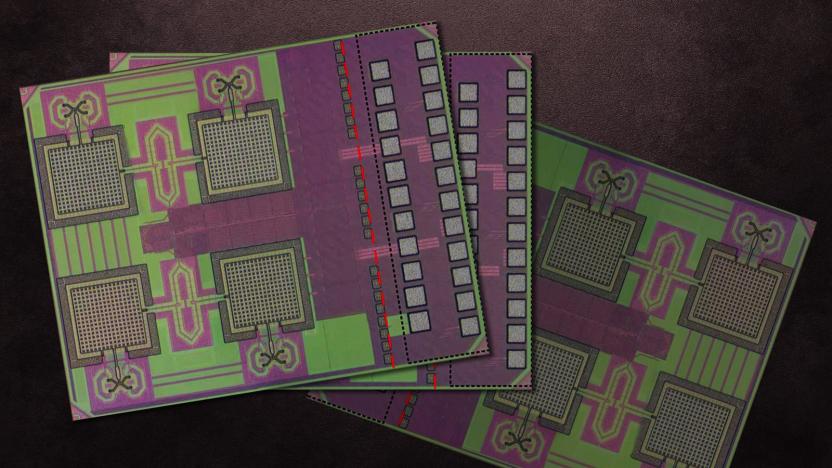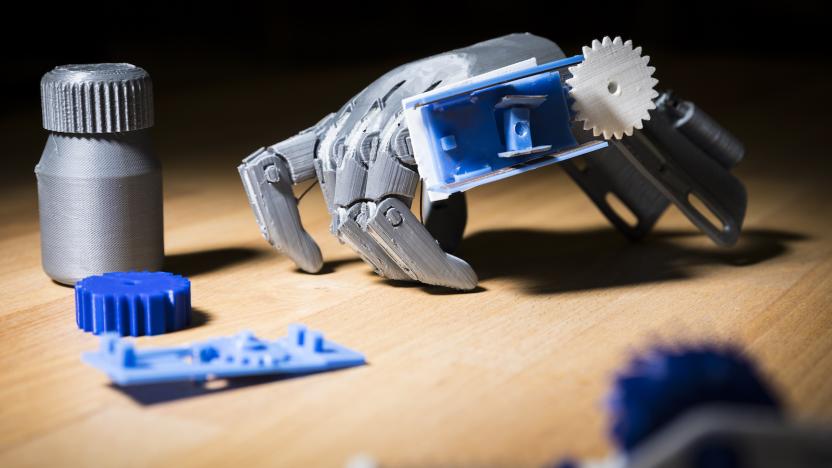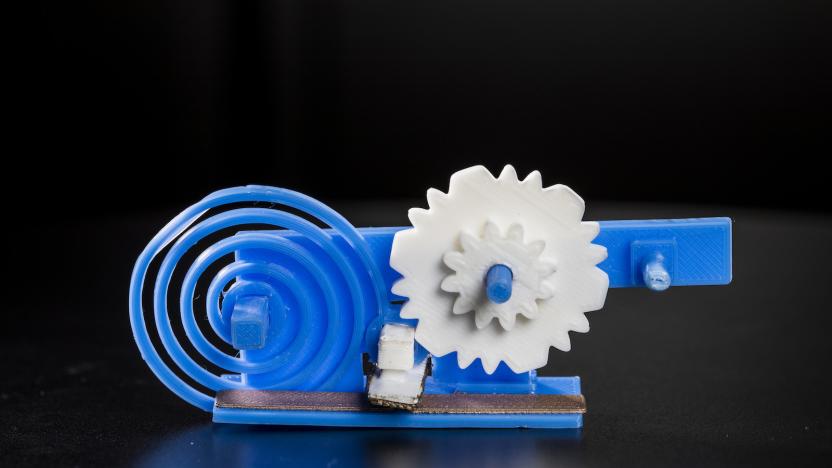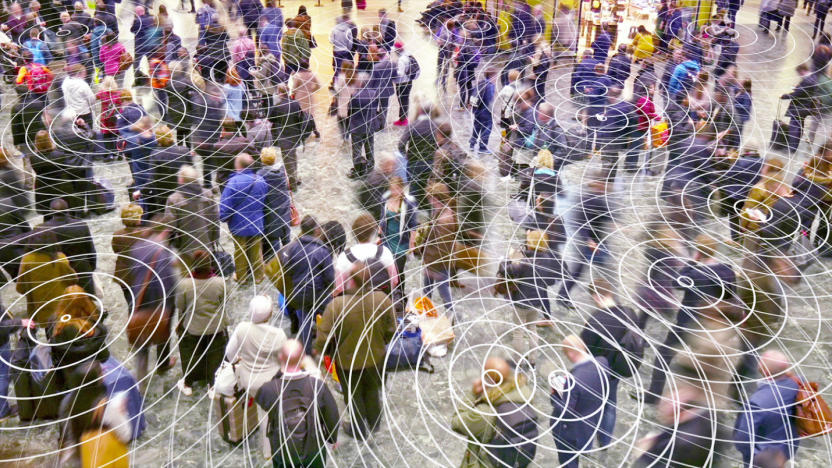backscatter
Latest

Minuscule ID chips could help spot even the smallest counterfeits
There are times when something is simply too small to tag it with existing technology, and that can be a serious problem when you're trying to fight counterfeits. MIT researchers might have a way to tag even the tiniest devices, though. They've created a very small (0.002 square inches) ID chip that's still secure enough to protect sensitive data. The team managed the feat through a monolithic chip powered solely by light, with antennas that use beam steering and RFID-style (but terahertz-level) backscatter to wirelessly send info to a nearby reader without requiring energy. These keep the design small while reserving enough electricity for encryption.

Researchers develop 3D printed objects that can track their own use
Researchers at the University of Washington have been developing a way for 3D-printed plastic objects to transmit data without the need for embedded batteries or electronics. Last year, they showed how their devices can take measurements of wind speed and liquid flow, and then transmit that information through an antenna that reflects ambient WiFi signals. Now, they're taking their work a step further, bringing the technique to assistive technology.

Researchers 3D-print WiFi-connected objects that don't need power
Researchers at the University of Washington have developed a way for 3D-printed plastic objects to transmit information via WiFi without the help of batteries or electronics. And they show that it can be done with commercially available plastics and WiFi receivers. "Our goal was to create something that just comes out of your 3D printer at home and can send useful information to other devices," Vikram Iyer, a graduate student on the project, said in a statement. "But the big challenge is how do you communicate wirelessly with WiFi using only plastic? That's something that no one has been able to do before."

Your future devices might not need wireless radios
Seemingly every connected device has at least one wireless radio in it. However, that often requires some big compromises. Those radios often chew up a lot of power, which isn't always practical with Internet of Things gadgets that may not have much room for a battery. Disney Research may have a solution to that problem: ditch the radios entirely. Its scientists have developed technology that uses ambient radio waves to communicate. The approach uses very low-power sensor nodes to reflect radio waves from virtually any background source, whether it's a distant tower or the phone in your pocket. RFID tags already use a similar approach, but the use of many more sources and multiple channels gives you a much longer range -- in tests, the researchers achieved data links at distances up to 164 feet.

Backscatter X-ray gun will help police hunt contraband
Though "strip-search" backscatter X-ray machines were pulled from US airports for privacy reasons, the tech has found a new home in the MINI Z portable scanner. Made by American Science and Engineering (AS&E), it displays see-through images on a Windows tablet PC from low-intensity backscatter X-rays that don't penetrate deeply into organic tissue. The company said it took seven years of research to shrink the X-ray tubes enough to create a handheld device that uses only 10 watts of power (see a simulation here or the video below). Scanning an object several times will even increase the detail. Backscatter X-rays don't penetrate deep into organic tissue, so the MINI Z is (theoretically) safe for operators and bystanders -- but it's not designed to scan humans anyway. Instead, the US military plans to put it to use searching for guns, explosives, drugs and organic materials. Its portable nature also makes it ideal for scanning vehicles, drug labs and hand baggage, to name a few scenarios -- so don't be surprised to see it at a customs checkpoint or concert near you. [Image credit: AS&E]

Phoenix's Sky Harbor airport puts omniscient X-ray to use
We don't envision very many people enjoying the idea of having TSA employees seeing every curve their body has to offer, but unfortunately for those who fail the primary metal detector test at Phoenix Sky Harbor International Airport, you could be in for such a treat. While airport shoe scanners have already garnered sufficient criticism for holding up the show rather than helping things out, the "backscatter" X-ray machine is officially being trialed in Arizona as a means of snuffing out hidden "explosives and other weapons" that can't be detected by other means. While the technology allows the viewer to see just about every follicle on your body (and any stray .500 Magnums adorning your person), there is still currently a workaround if you're not entirely comfortable with going full-frontal before boarding your flight. A TSA spokesperson proclaimed that the process is completely voluntary, as folks who get dinged by the metal detector can opt for a standard pat-down in order to clear things up. Interestingly, the officials operating the machine have reportedly "adjusted the equipment to make the image look something like a line drawing" rather than detailing all your 2,000 parts, but critics suggest that altering the image also hampers the chance of discovering contraband in the first place. Still, unless this causes some serious uproar in the near future, it looks like it's there to stay, and folks traveling through LAX and New York's Kennedy Airport will likely face a similar beast (if they so choose) before the year's end.

Phoenix airport set to test all-seeing x-ray
Phoenix Sky Harbor International Airport looks to have the distinct honor of being the first airport in the United States to put the controversial "backscatter" x-ray technology to use, the very same excessively-intimate inspection technique that made its debut at London's Heathrow airport a couple of years back. The airport won't just be taking a peek at everyone that passes through the gate, however, instead using the scanner as a backup to existing screening measures -- and, even then, individuals will have the option of a pat-down search instead of the picture postcard seen here. What's more, unlike earlier implementations of the technology, the Transportation Security Administration has reportedly sanitized the end results somewhat, with certain areas being discreetly blurred out, and no images saved after the person steps away from the machine. While the Phoenix airport gets to be first it, not suprisingly, won't be the last, with the TSA saying that a "handful" of other airports will be installing some scanners of their own sometime early next year.[Thanks, Ben B.]




